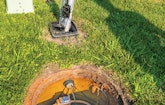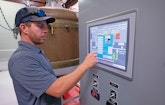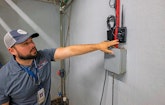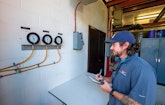
The York County Public Works Utilities team includes (from left) Ronald German, Tim Warthan, James Williams, Charles Meredith, Erik Kister, Curtis Carr, Brennon Grover and Mason Hionec. (Photography by Kevin Blackburn)
Interested in Infrastructure?
Get Infrastructure articles, news and videos right in your inbox! Sign up now.
Infrastructure + Get AlertsNeither gravity nor vacuum can solve every sewer problem. In York County, Virginia, they play an equal role in providing safe collections for the community and protecting one of the country’s most sensitive and important watersheds.
Situated on the beautiful coastline of Chesapeake Bay, York County has found ways to migrate off septic systems, combat inflow and infiltration and deal with high water tables by utilizing a combination of gravity and vacuum sewer systems in conjunction with grinder pumps. Specialized departments have been the key to keeping all the diverse elements of this unique collections system performing optimally.
York County is an older community, established originally in 1781. Its sanitary collections systems are relatively new to the region, however, with the oldest public sewer segments being installed in the 1950s. The county’s topography and size are unusual in that it is 40 miles long but only 3 miles wide, divided into two sections by U.S. Navy bases.
Situated along the multipeninsular coastline of the Chesapeake Bay, it serves a population of 75,000 with 26,000 sewer connections. Between the upper and lower sections, York County has 82 miles of vacuum sewer with 1,675 vacuum pots, 245 miles of gravity sewer with 15 miles of high-pressure mains and 15 miles of low-pressure force main, 25 lift stations, along with 45 pump stations, 9 vacuum stations and around 285 grinder pumps.
York County’s first comprehensive plan was adopted in 1991 and is updated approximately every five years. The comprehensive plan among many things sets a planned course for land use and allowable housing densities, which guides development. The County also initiated a Utilities Strategic Capital Plan for extending sanitary sewer and water to existing developed neighborhoods. The goal of that plan was to replace the private onsite septic systems with public sanitary sewer, and connect properties with private wells to the public water system. Those neighborhoods that were developed on the tributaries of the Chesapeake Bay were top priority.
Since the upper and lower collections systems incorporate both gravity and vacuum and are so diverse, the county utility operations has five sections to deal with the ongoing maintenance, monitoring and rehabilitation of the systems: preventive maintenance, construction, pump stations, vacuum and grinder pumps/force mains.
A critical shift
In conjunction with the Chesapeake Bay Act, in the 1980s, York County began extensive research on how to get residents who were on septic systems converted over to public sewer. Because many of these residents and onsite systems were located right on the tributaries of the bay, there were significant environmental concerns regarding the private septic systems leeching into the waters of the bay. Michael Elam, P.E., project engineer in the early 1990s, presented vacuum sewers as a viable solution since installation of gravity sewers in areas with high water tables was not financially feasible. At the time, this was a relatively new technology for sanitary collections systems, so the county visited a neighboring jurisdiction also situated on the bay that had installed a vacuum system in 1972 and was experiencing positive results.
York County decided to move forward with its first vacuum system in the mid-1990s. Nine different areas of the county are now served by vacuum.
Better monitoring
The Hampton Roads Sanitation District handles the sanitary sewer treatment for the Hampton Roads area, which is comprised of nine cities, four counties (including York) and one town. In 2007, the district was placed under an Order by Consent to eliminate all sanitary sewer overflows.
“York County was in very good shape because our systems are, in the grand scheme of things, young,” shares Tim Warthan, York County’s superintendent of utilities.
The County established an extraordinarily strong program of CIP projects, including lining of gravity lines, manhole inspections and rehabilitation, and pump station rehabilitation. It also developed a continuous PM program along with smoke testing to help identify inflow and infiltration sources. In addition to its CIP and PM programs, HRSD also came up with a program, Smart Water Initiative For Tomorrow.
“Instead of discharging treated effluent water into the tributaries of the Chesapeake Bay, HRSD is now injecting a portion of the treated wastewater back into the groundwater, which over time should help the local environment tremendously,” Warthan says. York County also monitors flow rates before and after each rehabilitation project to accurately determine the impact on inflow and infiltration.
The Order by Consent made York County and its neighboring localities learn more about their sanitary sewer collections systems throughout the process. York’s collections system is maintained at a higher level now through education, NASSCO certification training, knowledge and flow monitoring using an FMS (Flovac Monitoring System) telemetry system. Each vacuum interface valve or connection has a magnet located inside of the top section of the valve body. The telemetry system works by attaching a special sensor to the valve body to detect the movement of this magnet. It detects each time the valve opens and closes, as well as how long each valve stays open.
The valves have a typical average number of firings during normal conditions so the volume of flow can be calculated based on the number of activations. When a higher than normal volume of water enters the sump, the valve will take in a larger quantity of fluid during that one cycle and be outside normal tolerances and an alert will be sent to the crews to take appropriate action. The data is captured in real-time and this enables quick response.
“The biggest advantage to having an ongoing flow monitoring program is the ability to quickly identify infiltration,” Warthan says. “When you’re able to identify infiltration, you cut your run times at your stations, which leads to saving energy and in turn saves money, and our system simply runs better. Plus, we’ve experienced a significant reduction in our work orders or service requests.”
Keeping it running
York County has dedicated, multifaceted teams to maintain its gravity and vacuum systems. Within a gravity system each of the sections and associated lift stations can vary widely, so the teams must learn about the personality of each asset. With its vacuum stations, components are pretty much the same. Although vacuum stations are similar to gravity stations in that they perform a similar function, vacuum stations have twice the amount of equipment to be maintained and monitored so different skills sets are required.
To help its vacuum team, York County has incorporated an elaborate control system for its stations with most of its pumps being controlled and run on variable frequency drives. But even with all this great monitoring technology, control systems and a highly skilled crew, York County’s biggest challenge is often out of its control — Mother Nature.
The Chesapeake Bay region is susceptible to violent weather events caused by nor’easters that can create more system maintenance problems than a hurricane. Because of this, York has established storm preparedness protocols and does its best to prepare many of the low-lying areas served by its vacuum system from becoming waterlogged.
“Recovering a vacuum system that has been overcome with water from a storm can be very costly,” Warthan says. “Our vacuum team has done an excellent job of mitigating these instances and finding effective ways to work through them.”
Driven by data
With its telemetry monitoring system, SCADA, ESRI ArcView GIS and Infor asset management system, York can collect extensive data on the health and performance of its systems and operations. This data leads the way in creating programs for ongoing maintenance and expansion of their systems should development require it.
“Just because things were done in certain ways in the past, it’s important to recognize that new developments will occur and that the way we’ve been addressing things before may not have been the best way to do things,” says Charles Meredith, a vacuum mechanic with York County Utilities. “When new information does point this out it’s OK to sit back, listen and assess because by doing so, we’ve learned some new things that have really been helpful in our everyday work.”
Sharing this data and information with the community has become increasingly more important so that the residents become partners with the county utility teams in ensuring the health of the sewer systems and the surrounding environment.
“It’s important that we educate our community about the cost of treating water and understand that it costs more to treat water once you’ve used it than it does to buy it, and what it takes to perform the work we do. I often like to share one of my favorite quotes from Gandhi when I speak at community events, ‘Sanitation is more important than independence,’ to emphasize its importance,” Warthan says.
Lasting legacy
Recognizing the need to create a sustainable collections system, the migration away from septic and openness to utilizing multiple methods has set York County up for the long run.
“We need to thank the people who were here before us who had the forethought to put the plan in place for getting septic tanks converted to collections systems so they could no longer impact the bay. They created amazing projects that have lasted for almost 50 years. Our director, Brian Woodward, has had a big hand in that, and thanks to that forethought we now have a small, manageable number of septic tanks left,” Warthan says.
With an arsenal of gravity, vacuum or low-pressure grinding pumps, York will continue slowly chipping away to create a legacy system for its community.
“The business that we choose for our life’s work sometimes chooses us,” Warthan says. “Sometimes it’s challenging because it’s an unseen entity, but we understand that what we do is for the environment, for our fellow human beings, the betterment of our community, our country as a whole and the environment.”











